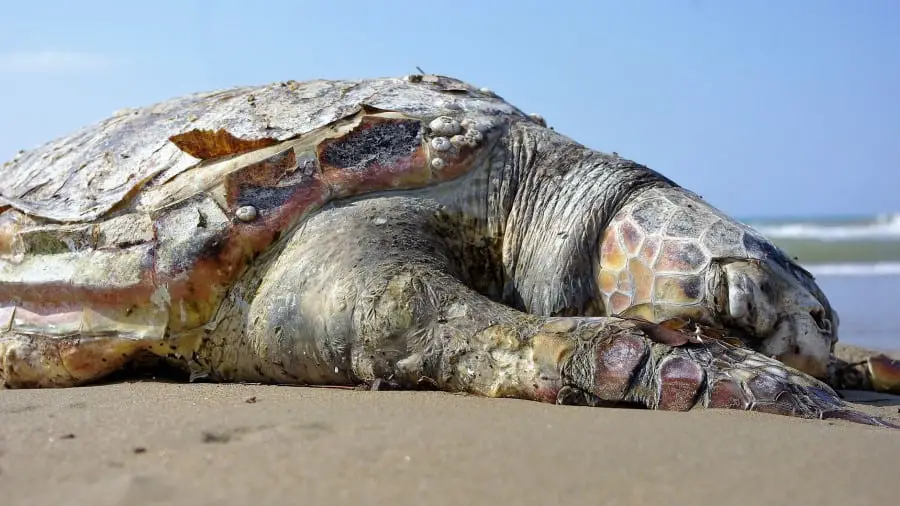
Any turtle owner who has had the misfortune of witnessing their turtle dying would know that it’s hard to differentiate whether it is dead or hibernating. This is simply because a dead turtle could still have movements. As scary as it may sound, that is the truth about turtles.
The main reason behind turtles being able to keep moving their body parts after death is the way they are built. A combination of their slow metabolic rate, high concentration of ions, and a heart that keeps beating even without any signal from the brain.
Turtles are known for their slow-paced life and extended mortality that could span up to centuries. However, with deforestations and concrete jungles being expanded, the chance for a wild turtle to stay alive for years has been gradually decreasing.
The Reasons Turtles Keep Moving Even After Death
A simple search through the internet would show you that there are many videos on animals who had been decapitated or death yet their body could still move.
An example of it is that of a man from India who decapitated the head of a cobra snake only for it to bite him minutes later. Turtles also can keep moving after their death.
Their heart is estimated to keep beating up to 12 hours after death for certain species. So what is the magic behind turtles being able to move even after being pronounced dead?
Slow Metabolism Rate
The turtle’s long life span is usually related to its slow metabolism rate. With a slow metabolism rate, your turtle would take a longer time to break down its food, even up to two or three days per meal.
Moreover, during hibernation periods your turtle can further lower its metabolic rate. Your turtle’s slow metabolism helps in preserving its inner organs for a far lengthier period than that of a mammal.
This causes turtles to take a longer time to completely die, as their systems would shut down much slower.
Electrically Charged Ions
Ions in living organisms are basically electrically charged particles that are either positive or negative. Turtles have a high concentration of ions in their blood and tissue that stimulates heartbeat and maintains the moisture in their nerves.
By keeping its nerves moist, the turtle creates a direct stimulation pathway that skips commands from the brain while keeping the body parts moving.
The electrically charged ions are also found in the nerve cells of turtles, this allows the brain to continuously send commands to other body parts even if the heart has stopped beating.
Minimal Oxygen for Brains
Turtles are capable of functioning with very little oxygen flow to its brain. In comparison to a human brain, within an average of 8 minutes with insufficient oxygen, the human brain would go into hypoxia and slowly start to shut down.
Turtles brain, on the other hand, could function for hours with little to no oxygen. This is evident when you realize that some turtles can’t breathe underwater yet they only hit the surface every few hours to grasp for air.
Given the turtle’s brain could function with very little oxygen, it allows for the brain to operate even after the turtle stops breathing, stimulating responses that would be slow but still moving.
Beating Heart
The heart is considered the most important organ for a living organism. When a human dies, their heartbeat would slowly reduce and completely stop within a short time.
For a turtle though, even if its heart has been removed from its body, it could still continue beating for up to 12 hours. This is because the turtle heart has its own pacemaker-like cells that will actively take over whenever the brain fails to send through signals for any reason.
These pacemaker cells would ensure that the turtle’s heart would continue functioning for some time even after the brain is dead. Medical experts usually declare death once the heart stops beating.
For a turtle, it could have its head decapitated, completely drained of its blood, its body dissected and eaten by someone, yet be still considered alive. This is because its heart would still be continuing to beat for hours.
How to Differentiate If Your Turtle Is Dead or Brumating?
In many ancient civilizations, if a pet turtle was found to be dead, it is considered as bad luck for the owner. Hence, many turtle owners at those times used to bury their dead turtles in a hurry, sadly even hibernating turtles were mistakenly buried.
Hence, it’s important to know if your turtle is actually dead or simply brumating. There are several ways to identify if your turtle is dead.
Stimulate Your Turtle
The simplest way to know if your turtle is still alive is to stimulate it. Normally, when you poke or prod your turtle it will respond, even if it’s hibernating.
By disturbing your turtle during hibernation, you will be annoying it and it will usually respond by moving, retracting back into its shell, and sometimes even producing a hissing sound.
Although hibernating, your turtle will exhibit a very fast response with its legs or tail. By gently tapping your turtle’s tail or slightly pulling its legs, you will be able to witness your hibernating turtle rapidly responding.
However, if by chance your turtle is actually dead and not hibernating, then the response would be extremely slow or non-responsive.
Put Pressure on Your Turtle’s Cloacal Region
By gently applying pressure between your turtle’s tail and its cloaca, you would notice it quickly attempting to escape from you. In addition to that, some turtles would indeed extend their neck when pressure is applied to their cloacal region.
If your turtle doesn’t respond to this slight pressure, attempt to turn it back onto its shell. Most of the time, if the turtle is still alive it will move vigorously to turn itself back to the right position.
Bad Odor
Similar to any dead organism, if your turtle is dead, it will begin to decompose rather quickly and it will be followed by bad odors. This foul-smelling odor would result from microorganisms feeding on the dead turtle’s body tissues.
This odor is usually the first indication that your turtle has died. It usually takes just about a day for the dead turtle to begin releasing the odor.
In cool temperatures, it may take slightly longer for the pungent gases to be released. The gas that is released from the dead turtle is capable of making it buoyant.
If you suspect your turtle could be dead, you could place it in a water tank to see if it would float. However, you should keep in mind that even a living turtle could float if it wishes to.
Always be sure to check if there’s an odor originating from your turtle’s enclosure, whether it’s caused by your turtle or just the dirty water and leftover food from the enclosure.
Visual Signs
Turtles are capable of controlling their breathing by slowing it down or even holding their breath for a long time, yet at a certain point, they still would need to breathe.
When your turtle breathes, its lungs would pump the air, resulting in a subtle movement between its rear legs and tail or between its forward legs and neck. This is one way to observe if your turtle is still breathing.
If you do not notice any movement from your turtle, you can try placing a feather in front of its nostrils. See if there is any indication of the feather moving, as this would mean your turtle is still breathing.
To successfully run this test you will need to be patient before concluding if your turtle isn’t breathing and could be dead.
Veterinary Assessment
If you still have a lingering doubt that your turtle might not be dead, it’s best to consult a veterinarian. The vet would be able to provide you peace of mind by indicating whether your turtle is actually dead or not.
Sometimes, even after concluding that your turtle is dead, you might notice it moving. This could be due to your turtle not being dead but just seriously ill and still alive.
By immediately taking it to a vet, your turtle could be saved as the vet would be able to treat your turtle and prescribe recovery medications.
How Do Turtles Look When Its Death?
God forbid, if your turtle dies, it would take at least close to 12 hours before its body starts to stiffen up. While the body stiffs up, the turtle’s eye would start sinking in.
Nonetheless, after a couple of days, the stiffness of your dead turtle’s body would loosen up. You would also start noticing liquid particles dribbling out of the dead turtle’s mouth and nose.
By the time this happens, the body would already have begun to decompose, producing a bad odor. On another note, the amount of turtle road kills have increased in recent years.
Sadly, many don’t realize that a run-over turtle with a broken shell or even a decapitated head is still alive and suffering. The best you could do at that point is to euthanize the turtle and putting it out of its misery.
Conclusion
Your turtle’s body parts are capable of moving even though the turtle is dead. This is common with cold-blooded reptiles, however, turtles’ resilience to dying is stronger than most other animals.
Nevertheless, like any other living creature, there are ways to know if your turtle died. Due to its slow metabolic lifestyle, a dead turtle’s body parts could continue moving even after it dies.
A turtle’s heart could keep beating for hours after its demise. Whereas electrically charged ions in its nerve keep sending signals to other parts of its body. It is difficult to distinguish between a dead turtle and a brumating one.
However, there are several ways you could try to instigate your turtle to observe if it responds or move. Otherwise, you just have to wait and see if there are any signs of decomposition on the turtle.
The best is to always consult a vet when you are not sure.

